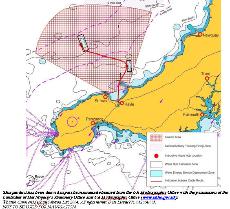Satellite images released on Sept. 14 revealed that sea ice has been melting at an alarming speed, setting Arctic ice levels at an all-time low. Consequently, the Northwest Passage has melted enough for ships to pass without an icebreaker for the first time on record.
“This is the least sea ice we’ve ever seen in the satellite record, and we have another month left to go in the melt season this year,” Boulder, Colorado, research scientist Mark Serreze, said to the Chicago Sun Times.
There has been a drop of one million square kilometers of ice in the past year alone, an extreme statistic when compared to the 100,000 square kilometers lost on average per year over the past 10 years. This melting is happening faster than computer climate models predicted. Experts speculate that the region of the Arctic where the Northwest Passage is could be ice-free by 2070, and all summer ice could be gone as soon as 2030.
“When the ice is there, because the ice is so white and bright it helps with cooling (by reflecting sunlight), but when it melts, the dark surface absorbs the heat and contributes more to global warming,” said sophomore and Forevergreen member Anne Marie Drolet.
This phenomenon is known as “positive feedback.”
Arctic ice melt shortens the hunting season for polar bears, and other Arctic wildlife, causing many to starve to death. Others drown trying to get from ice block to ice block while searching for prey. Government scientists predict that by 2050, two-thirds of the world’s polar bear population will be killed off due to melting sea ice.
Coastal flooding due to rising sea levels is another concern associated with melting ice in the Arctic.
The Northwest Passage has existed as a “hypothetical route” since the 15th century. Explorers who sought a route through the North Pole made unsuccessful attempts to pass through, often ending in their deaths.
Now that the ice has melted enough for ships to pass safely during the summer months, ships will be able to bypass the Panama Canal, shaving thousands of miles off the voyage from Europe to Asia.
However, tensions are developing, since the passage runs through both Canada and the United States. The Canadian government has stationed two new military bases in the Arctic and acquired six patrol ships, intending to regulate transit and collect fees.
“Canada has a choice when it comes to defending our sovereignty over the Arctic,” said Canadian Prime Minister Stephen Harper in a televised speech. “We either use it or lose it. And make no mistake, this government intends to use it. Canada’s arctic . represents the tremendous potential for our future.”
Meanwhile, the United States is insisting that the Northwest Passage be open for anyone to use.
“We believe it’s an international passage,” said President George Bush at a closing news conference.
Scientists believe that up to 25 percent of the world’s untouched oil and natural gas could be beneath the seabed in this region of the Arctic. This prospect has prompted advances by Russia, Denmark, and Norway, as well as the United States and Canada.
In August, Russia sent two submarines beneath the Arctic and planted a rust-proof, titanium Russian flag underwater, over where the oil is suspected to be.
“A continental shelf is an extension of a continent underwater. The Russians are making a claim that their shelf extends all the way across (to where the resources lay buried),” said Assistant Professor of Geology and Earth Sciences Dave Dobson. “The continental shelves are places where there’s a lot of biological productivity and that’s what turns into oil after millions of years.”
Some fear that all the new shipping traffic, as well as the collection of submerged oil, in this region will increase the amount of oil spills in the Arctic. Some have expressed concern that the opening of the passage for international use is a threat to U.S. security.
“Shorter transport routes means less pollution if you can ship products from A to B on the shortest route,” said Claes Ragner of Norway’s Fridtjof Nansen Institute (which studies environmental issues and their political implications,) to the Star, a Canadian newspaper. “But the fact that the polar ice is melting away is not good for the world in that we’re losing the Arctic and the animal life there.”
The U.S. Navy believes the Northwest Passage will be ready for regular use within 10 years. If this is the case, the United States is fast approaching tensions with allied nations and environmental concerns that were not expected to peak for another 20 to 30 years.
“As there was in the American West in the 1800s, there’s a great land grab going on, but (this time) most of the land is at the bottom of the seafloor,” Brookings Institution scholar, William Antholis, told ABC News.

